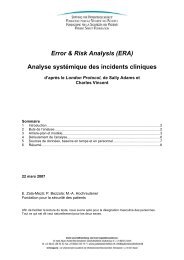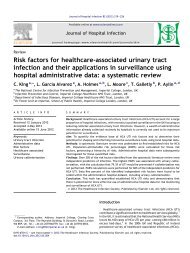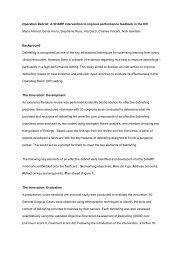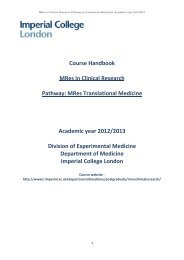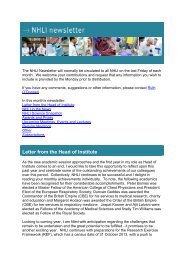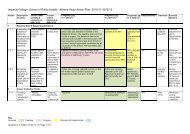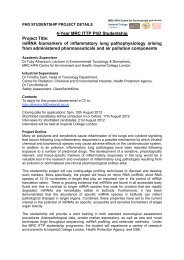An Introduction to qRT-PCR Assays Using Sybr Green (Using SDS ...
An Introduction to qRT-PCR Assays Using Sybr Green (Using SDS ...
An Introduction to qRT-PCR Assays Using Sybr Green (Using SDS ...
You also want an ePaper? Increase the reach of your titles
YUMPU automatically turns print PDFs into web optimized ePapers that Google loves.
that triplicates contain exactly the same reaction components – anydifferences between them are due <strong>to</strong> technical fac<strong>to</strong>rs and assay noise,allowing a measure of intra-assay variation <strong>to</strong> be calculated.8. Data <strong>An</strong>alysisThere are a number of approaches <strong>to</strong> data analysis, many requiring the use ofadditional ‘known’ samples in the form of a standard curve.In brief:2 - ∆∆ CTmethodThis is based upon an assumption of perfect doubling of <strong>PCR</strong> product percycle and will give a reasonable estimate of expression. <strong>An</strong> R0 value can besimply calculated for each sample:R0 = Threshold value x (2 -CT value )Eg: if threshold is 0.13 and a sample has a CT value of 21.65, then the R0 valuewill be 0.13 x (2^-21.65) = 3.95 x 10 -8 . The R0 values for target gene samples arethen divided by internal control gene R0 values, <strong>to</strong> give a gene expressionratio for each sample. The mean and standard deviation may then beexpressed relative <strong>to</strong> the mean of the experimental control group.Efficiency from Standard CurvesThe use of serial dilutions of cDNA (usually tenfold) can be used <strong>to</strong> moreaccurately determine efficiency for each primer set. This can also be done forcopy number standard curves, and using this efficiency the actual fold changeand variance achieved is mathematically identical <strong>to</strong> that produced fromusing copy numbers (see Peirson et al., 2003).Plot the CT of standards (y-axis) against log copy number or cDNAconcentration (will be negative for dilutions – eg: 100 fold dilution of cDNAgives concentration of 0.01, or –2 log units). Fit a linear regression trend-line<strong>to</strong> give the slope and fit. The correlation coefficient should be greater than0.95 <strong>to</strong> ensure accurate standards.The slope of the standard curve can be used <strong>to</strong> calculate efficiency:Applied efficiency = 10 (-1/slope)So a perfect amplifcation rate of 2 will have a standard curve slope of –3.32.Note: in many publications efficiency is referred <strong>to</strong> as a reaction rate, and isthus on a scale of 0 (no reaction) <strong>to</strong> 1 (maximum reaction). <strong>Using</strong> applied



